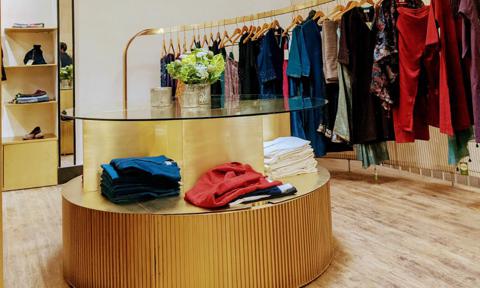
Sustainablity is in-built into designer Shani Himanshu’s core design philosophy. It’s almost like breathing to him. So it’s no surprise that the newly-opened apparel floor at Good Earth, Raghuvanshi Mills, which has been designed by him, is an extension of the same sustainable school of thought. Aside from the brand’s own Spring/Summer 2022 line, the new floor will also showcase designers, like Anavila, The Sole Sisters, Tilla, and Himanshu’s own 11.11, who champion Indian heritage textiles using environmentally-conscious practices.
Himanshu considers this a perfect union as the alignment of his principles with Good Earth’s allowed him to play around with the design and create an experience the customer would never forget. “Why would a person want to go out to buy something when everything is available at your doorstep nowadays?” he asks, “There has to be something new that a customer can experience at a store that makes them come there and stay for longer.” According to Himanshu, this became the basis of the whole design.
We talked to the designer about the process behind designing a sustainable space in 2022 and how it can be carried forward. Here’s an excerpt from our conversation…
HELLO!: What was the process behind the design of the space?
Shani Himanshu: “Basically, the brand we have is called 11.11, and we kind of keep doing experiences around how we display the products. When we showcased our Autumn/Winter’19 collection at our Khan Market space, we did a textile drape which intrigued Mrs. Anita Lal about how the space was converted, and that brought her into the notice that we do these kinds of experiences and that’s why she asked me to work on this apparel floor, which is almost 4000 sq feet in Raghuvanshi Mills. This was kind of an open playground, Mrs. Lal even called it a maidan, and it’s this 4000 sq feet of open space that has no columns, there are nice big beams that are running 16ft high on the ceiling, and that made us really excited about how we could transform the space. It was an industrial building, so I wanted to bring a more dynamic and delicate form within the space to create a contrast. This is why the brass forms started coming in and we started formulating on the way we could hang the garments. This also made us introduce partitions to the space in the form of translucent screens which are 20ft wide and 16ft high, which allowed us to showcase each individual brand beautifully. It was actually the space that ultimately inspired me to come up with the idea.”

H: The floor now houses many fashion labels that subscribe to the sustainability philosophy. Was that an inspiration while coming up with the design concept for the space?
SH: “At 11.11, we live by the philosophy of questioning whatever you’re using. That includes anything we would do. For instance, we used brass because it’s a pure material and it ages beautifully. Sustainability, for me, is not something that can be questioned. It needs to be a part of your life in every form. When you go to buy apples, you’re only going to buy organic apples, right? You will not even consider ‘pesticide apples’. It’s that simple.”
H: Can you tell us some of the highlights of the space that makes it sustainable?
SH: “Brass needs very high skill craftsmanship since it’s one of the most difficult and pure materials. But it ages beautifully with time. Then we have added large screens with hand printing done using natural dyes. So these are individual landscape artworks created on a cotton screen, done with all-natural colours. Another natural material that we’ve featured here is wood, which is just scraped off and not polished with a chemical, and it’s kept naked with just some wax. With proper maintenance, these materials can age really well over time. There are brass sculpture-like installations at each display, which actually double up as storage. Anything we were planning on including had to have a functionality to it, it couldn’t just be there for superficial aesthetics.”

H: What does sustainability in design and architecture mean to you in 2022?
SH: “I think it’s important for any designer to consider sustainability in their process, not just in 2022 but all the time. For me, it is not about just following it because it’s trendy to do so, but that’s just how it should be all the time. People are usually not aware of what they’re consuming and how it was created, and that’s why they might be making choices that are not sustainable. But being a designer, it’s my responsibility to create things sustainably because I’m aware and that’s on me now. When a brand like Good Earth, which follows the same principles, comes to you, then it’s easier to go beyond just sustainability. You can focus on creating an experience out of the space. Sustainability is just a given parameter for us.”
H: What are some of the practical recommendations you would give to someone who wants to be more environmentally conscious while designing their space?
SH: “In this case, one of the first things we decided was to retain the structure of the space. We liked the old flooring, which was kind of a broken, industrial concrete floor. We decided to incorporate that into our design for the space. Doing something like that brings down a huge percentage of the carbon footprint of redoing the entire flooring of such a huge space. So I would recommend trying to identify and retain as much of the older structures as possible while doing up space and embracing its raw-ness. For me, it adds to the soul of the structure. You should also go for pure materials because they age well. When something is ageing, that means it’s breathing.”






